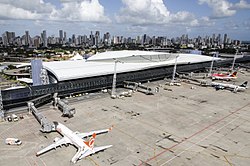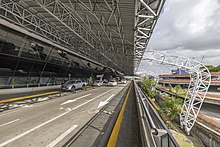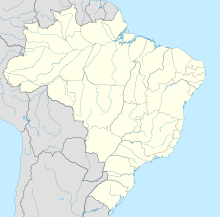Recife/Guararapes–Gilberto Freyre International Airport
Recife/Guararapes–Gilberto Freyre International Airport Aeroporto Internacional do Recife/Guararapes–Gilberto Freyre | |||||||||||
|---|---|---|---|---|---|---|---|---|---|---|---|
 | |||||||||||
 | |||||||||||
| Summary | |||||||||||
| Airport type | Public | ||||||||||
| Operator | |||||||||||
| Serves | Recife | ||||||||||
| Hub for | Azul Brazilian Airlines | ||||||||||
| Focus city for | Gol Transportes Aéreos | ||||||||||
| Time zone | BRT (UTC−03:00) | ||||||||||
| Elevation AMSL | 10 m / 33 ft | ||||||||||
| Coordinates | 08°07′35″S 034°55′22″W / 8.12639°S 34.92278°W | ||||||||||
| Website | www | ||||||||||
| Map | |||||||||||
 | |||||||||||
| Runways | |||||||||||
| |||||||||||
| Statistics (2022) | |||||||||||
| |||||||||||
Aeroporto Internacional do Recife/Guararapes–Gilberto Freyre (IATA: REC, ICAO: SBRF) is the airport serving Recife, Brazil. Since December 27, 2001 it is named after the Recife-born Anthropologist and Sociologist Gilberto de Mello Freyre (1900–1987).[5] Some of its facilities are shared with the Recife Air Force Base of the Brazilian Air Force.
Since 2019 it is operated by AENA, a Spanish public corporate.
History
Originally called Ibura Airport, the airport had its name changed to Guararapes Airport in 1948. The facility originated during World War II, when a new airport was built to replace the earlier airfield, Parque do Encanta Moça. With the end of the War, the facility became strategically important as a technical and refueling stop on the route from South America to Europe.
On July 21, 1953, within a law prescribing rules for the naming of airports, the name of the facility was officially and exceptionally maintained as Guararapes Airport.[6]
On 18 January 1958, a new passenger terminal was inaugurated, replacing the original facility. During this time, runway 14/32 was extended from 1,800 to 2,010 m (5,910 to 6,590 ft), and runway 18/36 was extended from 1,800 m to 2,400 m (7,900 ft).
In 1979, an agreement with Infraero was made in order to further develop the airport complex. The passenger terminal underwent its first major renovation in 1982, and another enlargement occurred in 1990.
In 2004, a brand-new passenger terminal was built, including a new shopping mall, thus generating more traffic and revenue. Furthermore, a new concourse was opened in 2004, and the airport's capacity increased from 1.5 to 9 million passengers/year. Today, the runway is 3,300 meters (10,800 feet) long, the longest in Northeastern Brazil.
On 31 August 2009, Infraero unveiled a BRL 8.75 million (US$4.6 million; EUR 3.2 million) investment plan to upgrade Guararapes International Airport, focusing on the preparations for the 2014 FIFA World Cup in Brazil, Recife being one of the venue cities. The investment was spent in finishing the passenger terminal renovation and installing eight more jetways.[7] The work was completed on 1 July 2011, and the airport was then considered ready for the FIFA Cup.[8]
Responding to critiques to the situation of its airports, on May 18, 2011, Infraero released a list evaluating some of its most important airports according to its saturation levels. According to the list, Recife was considered to be in good situation, operating with less than 70% of its capacity.[9]
Previously operated by Infraero, on March 15, 2019, AENA won a 30-year concession to operate the airport.[10]
The Brazilian Integrated Air Traffic Control and Air Defense Center, section 3 (Cindacta III) is located in the vicinity of the airport.[11]
The facility covers 319 hectares (788 acres) of land.[12]



Airlines and destinations
Passenger
Note:
a: Flights operated with Voepass equipment on behalf of LATAM Brasil.
Cargo
| Airlines | Destinations |
|---|---|
| Lufthansa Cargo | Campinas,[15] Curitiba,[15] Frankfurt[15] |
| LATAM Cargo Brasil | Miami |
| Modern Logistics | Brasília, Campinas, Manaus |
Accidents and incidents
- 1 November 1961: a Panair do Brasil Douglas DC-7C registration PP-PDO flying from Sal to Recife, during its final approach struck an 84-m hill 2.7 km from the runway and broke up. The aircraft was doing a night approach too low and outside the regular traffic pattern. Forty-five passengers and crew out of the 88 persons aboard died.[16][17] The aircraft was operating the Voo da amizade (Friendship Flight).
- 11 November 1991: a Nordeste Embraer EMB110P1 Bandeirante registration PT-SCU, operating flight 115 from Recife to Maceió, during on initial climb had an engine failure followed by fire. The aircraft crashed on a populated area. All 13 aircraft occupants and 2 persons on the ground died.[18][19]
- 23 November 2008: a Beechcraft Super King Air operated by JC Show Ltda crashed 5km (3.1mi) N on final approach to REC when both engines quit possibly because of fuel starvation and carried out a forced landing in a residential area. Two occupants out of 10 on board died.[20]
- 13 July 2011: a Noar Linhas Aéreas Let L-410 Turbolet registration PR-NOB operating flight 4896 from Recife to Natal crashed shortly after take-off from Recife. All 16 occupants were killed.[21][22]
Access
The airport is located 14 km (9 mi) from downtown Recife.
Recife's subway Airport Station is connected to the terminal by a footbridge. Besides main bus lines that serve the neighborhoods of Boa Viagem and Cidade Universitária, in Recife, and Piedade, in Jaboatão dos Guararapes.
See also
References
![]() This article incorporates public domain material from the Air Force Historical Research Agency
This article incorporates public domain material from the Air Force Historical Research Agency
- ^ "Informações Estatísticas". Aena Brasil (in Portuguese). Retrieved 26 May 2022.
- ^ "Aeroporto Internacional do Recife Gurararapes-Gilberto Freyre". Aena Brasil (in Portuguese). Retrieved 3 May 2022.
- ^ "Aeródromos". ANAC (in Portuguese). 29 June 2020. Retrieved 9 April 2021.
- ^ "Guararapes - Gilberto Freyre (SBRF)". DECEA (in Portuguese). Retrieved 30 August 2023.
- ^ "Lei nº 10.361, de 27 de dezembro de 2001". Presidência da República (in Portuguese). 8 July 2002. Retrieved 1 November 2023.
- ^ "Lei no 1.909, de 21 de julho de 1953". Presidência da República (in Portuguese). 21 July 1953. Retrieved 15 October 2023.
- ^ Rittner, Daniel; Braga, Paulo Victor (31 August 2009). "Infraero vai gastar R$5 bi em reforma de aeroportos". Valor Econômico (in Portuguese). pp. A4. Archived from the original on 6 July 2011. Retrieved 4 October 2019.
- ^ "Infraero conclui obra no Aeroporto Internacional do Recife" (in Portuguese). Diário de Pernambuco. 1 July 2011. Archived from the original on 7 October 2011. Retrieved 1 July 2011.
- ^ "Governo muda critério de avaliação e 'melhora' desempenho de aeroportos" (in Portuguese). O Estado de S. Paulo. 19 May 2011. Retrieved 20 May 2011.
- ^ "Governo obtém R$ 2,377 bilhões em concessão de aeroportos em blocos". ANAC (in Portuguese). 15 March 2019. Archived from the original on 11 May 2019. Retrieved 1 October 2019.
- ^ "Cindacta III" (in Portuguese). Brazilian Air Force: Departamento de Controle do Espaço Aéreo DECEA. Archived from the original on 30 July 2012. Retrieved 4 May 2011.
- ^ "Characteristics-Recife Int'l Airport". aenabrasil.com.br. Retrieved 22 October 2023.
- ^ "Setor de turismo cabo-verdiano e CVC assinam memorando que prevê voos para o Brasil em 2024". Aeroin (in Portuguese). 23 December 2023. Retrieved 23 December 2023.
- ^ "GOL Plans to Resume Recife – Fernando de Noronha in 2H24". Aeroroutes. Retrieved 26 December 2023.
- ^ a b c "Schedule". Lufthansa Cargo. Retrieved 23 July 2020.
- ^ "Accident description PP-PDO". Aviation Safety Network. Archived from the original on 3 November 2012. Retrieved 20 May 2011.
- ^ Germano da Silva, Carlos Ari César (2008). "Buraco negro". O rastro da bruxa: história da aviação comercial brasileira no século XX através dos seus acidentes 1928–1996 (in Portuguese) (2 ed.). Porto Alegre: EDIPUCRS. pp. 197–203. ISBN 978-85-7430-760-2.
- ^ "Accident description PT-SCU". Aviation Safety Network. Archived from the original on 3 November 2012. Retrieved 20 May 2011.
- ^ Germano da Silva, Carlos Ari César (2008). "Fogo na decolagem". O rastro da bruxa: história da aviação comercial brasileira no século XX através dos seus acidentes 1928–1996 (in Portuguese) (2 ed.). Porto Alegre: EDIPUCRS. pp. 364–369. ISBN 978-85-7430-760-2.
- ^ Accident description for PT-OSR at the Aviation Safety Network. Retrieved on October 22, 2023.
- ^ "Accident description PR-NOB". Aviation Safety Network. Archived from the original on 4 November 2012. Retrieved 13 July 2011.
- ^ "Noar emite comunicado sobre acidente em Recife" (in Portuguese). Panrotas. 13 July 2011. Archived from the original on 17 March 2012. Retrieved 13 July 2011.
External links
- Airport information for SBRF at Great Circle Mapper. Source: DAFIF (effective October 2006).
- Current weather for SBRF at NOAA/NWS
- Accident history for REC at Aviation Safety Network

